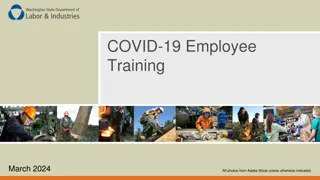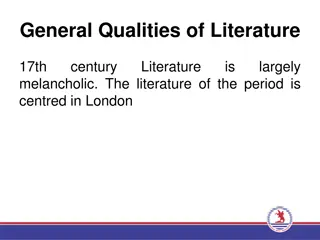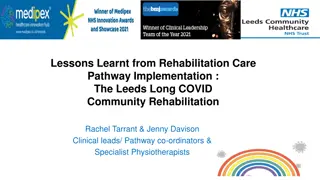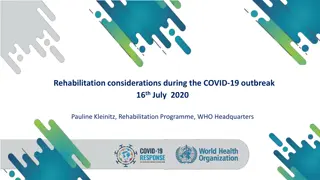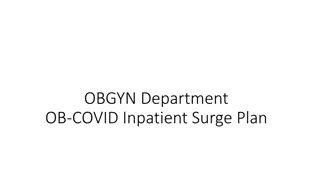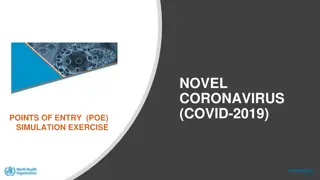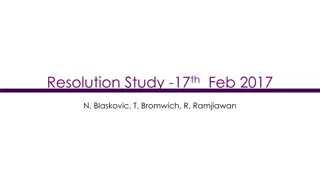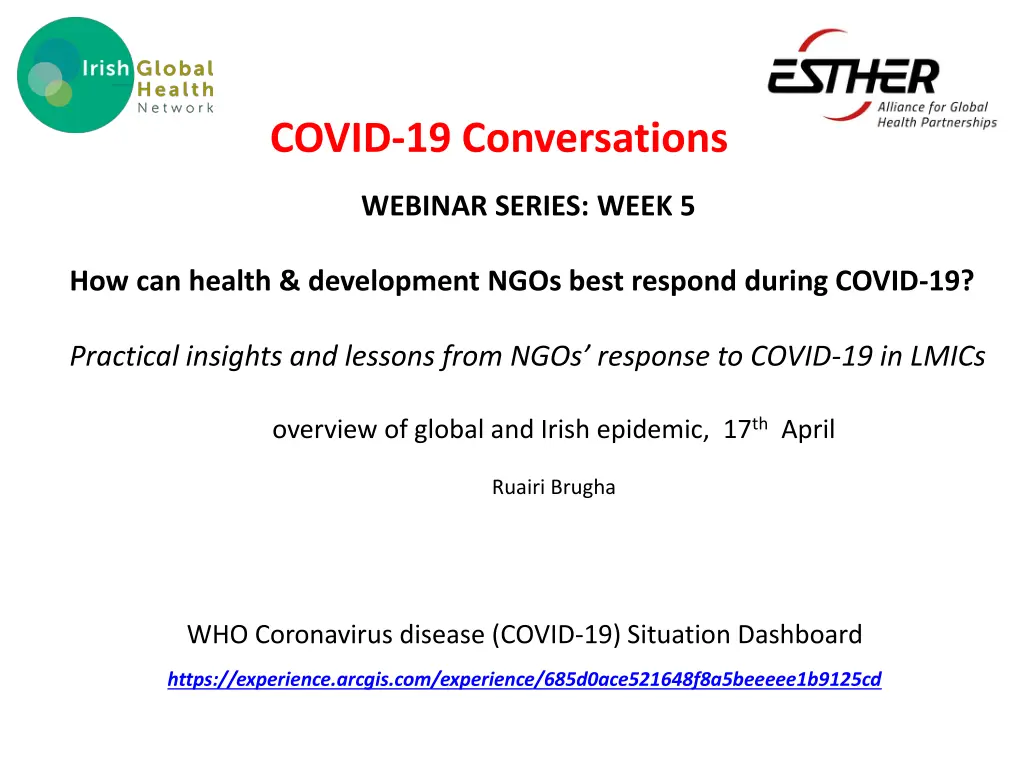
NGO Response to COVID-19: Insights and Global Trends
Discover how health and development NGOs are navigating the COVID-19 pandemic, with practical insights from responses in LMICs. Explore country trends in cases and deaths, with a specific focus on Ireland. Uncover current issues and strategies for moving forward in the face of the pandemic.
Download Presentation

Please find below an Image/Link to download the presentation.
The content on the website is provided AS IS for your information and personal use only. It may not be sold, licensed, or shared on other websites without obtaining consent from the author. If you encounter any issues during the download, it is possible that the publisher has removed the file from their server.
You are allowed to download the files provided on this website for personal or commercial use, subject to the condition that they are used lawfully. All files are the property of their respective owners.
The content on the website is provided AS IS for your information and personal use only. It may not be sold, licensed, or shared on other websites without obtaining consent from the author.
E N D
Presentation Transcript
COVID-19 Conversations WEBINAR SERIES: WEEK 5 How can health & development NGOs best respond during COVID-19? Practical insights and lessons from NGOs response to COVID-19 in LMICs overview of global and Irish epidemic, 17thApril Ruairi Brugha WHO Coronavirus disease (COVID-19) Situation Dashboard https://experience.arcgis.com/experience/685d0ace521648f8a5beeeee1b9125cd
COVID-19: country trends in cases and deaths 12th March 80981 3173 19th March 81174 3242 26th March 81961 3293 3rd April 82802 3327 10th April 83249 3344 17th April 83797 3352 Country China No. of cases No. of deaths Italy No. of deaths No. of cases 12462 827 35713 2978 74386 7505 110574 13157 139422 17669 165155 21647 USA No. of cases No. of deaths 987 7087 100 63570 884 213600 3846 395030 12740 604070 25871 29 UK No. of cases No. of deaths 460 6 2630 103 9533 463 29478 2532 60737 7097 98480 12868 Ireland No. of cases No. of deaths 43 292 1564 9 3849 98 6224 235 13271 486 1 2 South No. of cases Africa No. of deaths 13 116 709 0 1462 5 1845 18 2506 34 0 0 Nigeria No. of cases No. of deaths 2 8 46 174 276 373 11 0 0 1 2 6 Malawi No. of cases No. of deaths 0 0 0 3 0 8 16 2 0 0 0 1
Ireland: 14th 16th April 2020 31st March 2nd (3rd) April 7th-10th April 14th-16th April IRELAND Number of cases 2677 3849 6,574 12,547 (13,271) Community transmissions Local transmissions Travel Unknown 598 (22%) 331 (12%) 294 (11%) 1396 (52%) (60%) (23%) (17%) 67% 24% 9% 52% 42% 6% No. of clusters No. of clusters in private houses 26 No. of clusters in nursing homes / residential institutions 118 134 (160) 317 39 (14%) 408 (425) 51 (12%) 24 86 (32%) 209 (51%) 254 (55%) No. of clusters in hospitals 21 46 (17%) 60 (15%) Health care workers 647 (24%) (841) 1765 (27%) 2872 (26%) Hospitalisation ICU admission Deaths 703 113 64 834 (932) 126 (134) 98 1521 230 (242) 263 1968 280 435 (444)
N e w a s e s p e r d a y 1400 00 1200 00 1000 00 New cases per day 800 00 R 3.7 R 2.4 600 00 R 1.2 400 00 200 00 0 29- Feb 30- Mar 29- Apr 29- May 28- Jun 28- Jul 27- Aug 26- Sep 26- Oct 25- Nov
N e w c a s e s p e r d a y 200 0 180 0 160 0 New cases per day 140 0 R 2.4 R 1.0 100 0 120 0 R 0.8 Confirmed cases 80 0 60 0 40 0 20 0 0 29- Feb 30- Mar 29- Apr 29- May
Current issues (Ireland) Hidden epidemic in nursing homes and residential institutions 55% of deaths there, accounting for much of the current upward trend in cases Reproduction rate R now between 0.7 and 1.0 elimination of COVID-19 from Ireland is feasible but may not be achievable 5th May = current date for reviewing distancing measures / closures Road map from govt on how to safely relax some measures before then But vaccine (12-18 months?) needed to get back to a new normal Joint European Roadmap towards lifting COVID-19 containment measures. 15th April https://ec.europa.eu/info/sites/info/files/communication_- _a_european_roadmap_to_lifting_coronavirus_containment_measures_0.pdf Still very little attention on our partner countries
EQUINET Information sheets Sheet 2: April 1st there is debate . . . on the feasibility and public health effectiveness of prolonged suppression (lockdowns) without widespread and systemic testing, given also concerns about the economic and social effects of lockdowns Researchers at the University of Jo burghave questioned whether flattening the curve is the best approach in ESA countries, given young populations, many informal residents and workers, inadequate water supplies and income security and health systems with an extremely limited coping capacity Experts within the UN Human Rights Council observe that human rights must be maintained in confronting COVID-19, without exception . They note that scarcity of resources should never justify discrimination against certain groups of patients, including people with disabilities, older persons, minority communities, internally displaced people and those living in extreme poverty, as well as people in detention, homeless people and refugees https://www.equinetafrica.org/sites/default/files/uploads/documents/EQUINET %20COVID%20brief2%20%201April2020.pdf
EQUINET Information sheets Sheet 3: April 15th A WHO COVID-19 readiness assessment with 34 African countries found only 29% to have adequate readiness with just over half the countries having available and accessible PPE for healthcare workers, including for products that could be locally produced. Apart from South Africa, Mauritius and Kenya, testing per capita remains low in the region. Even in countries with higher rates of testing, the levels still fall short of public health targets Local production of masks and PPE for health workers has expanded and Enterprises at different scales and universities are producing CPAP and ventilator equipment . . . . In Zimbabwe, Uganda and South Africa progress on debt relief https://www.bing.com/search?q=equinet+information+sheet+3+on+covid- 19&form=EDGTCT&qs=PF&cvid=cc5733b0bb03472cb2c79ee9634abdee&refig=a227af27b3e2453e86e0 d8ac24d62f9a&cc=IE&setlang=en-US&plvar=0
How can we control COVID-19 in our partner countries? 1. Protect health workers (PPE gloves, masks, soap, etc) 2. Put surveillance systems in place (data for advocating for resources) o testing capacity o measure impact hospital data, deaths, burials ! 3. Appropriate technology to treat Adult Respir Distress Syndrome o oxygen o respirators ? (if local production and equity feasible) 4. Avoid doing harm: ? Large scale testing and treatment of COVID-19 is this the best use of resources? ? Social distancing needs to be part of a long-term strategy X Lockdowns imposed by government hit the poorest / most vulnerable 5. Participate in efforts to find a safe effective vaccine
What measures are appropriate to needs / contexts? Protect health workers (PPE gloves, masks, water, soap, etc) Surveillance (strengthen but target testing capacity) Maintain essential health services e.g. EPI, Safe motherhood Maintain / strengthen other essential programmes food security Engage with donors around re-allocating funds to priority areas Protect the most vulnerable cash transfer, safety nets

